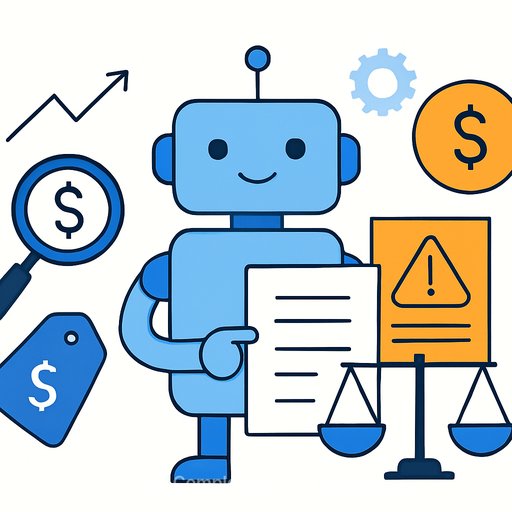AI Is Squeezing the "Rip-Off Economy." Finance Leaders Should Lean In
Information gaps made a lot of money for middlemen. AI is closing those gaps, pushing markets toward clearer pricing and cleaner incentives.
For finance teams, this shift doesn't just cut costs. It rewires how fees, risk, and trust get priced-and who keeps the spread.
Used Cars Proved the Point
Historically, buyers overpaid because they couldn't see a car's true condition. Now, models parse accident records, service logs, title history, and even listing language to pin fair value in seconds.
When uncertainty drops, spreads shrink. That's the same pressure hitting fees and opaque terms across financial products.
Finance: Fees, Terms, and Trust
Hidden charges and complex contracts thrive on asymmetry. AI contract readers catch junk fees, prepayment traps, and coercive clauses in real time-before a customer signs.
Robo-advisors and execution algorithms compress spreads that old-school brokers captured. Efficiency improves, but it forces margin transparency and changes how advisory teams create value.
Expect two outcomes: lower average fees and fewer surprises. Also expect a skills reset across advisory, ops, and compliance as models take over repetitive analysis.
Healthcare Pricing: A Preview of What's Next
Patients used to get blindsided by billing. Cost-prediction engines trained on claims data now estimate prices up front and auto-negotiate to reduce overbilling.
Some reports suggest this shift could deliver massive savings in the next decade. The lesson for finance: the same playbook applies to mortgages, credit cards, wealth, and insurance-quote clearly, verify instantly, and remove friction.
Macro Effects You'll Feel on the P&L
As asymmetry fades, markets get more efficient. That typically means lower spreads, faster price discovery, and tighter risk premiums.
There's a catch. If a few vendors control the pricing engines, market power consolidates. You could trade one set of hidden costs for another if governance is weak.
Risks to Manage Early
- Bias: poorly curated data can skew prices or approvals by demographic.
- Privacy: contract and transaction data needs strict access controls and audit trails.
- Security: model supply chain and prompt-injection risks require active defense.
- Vendor lock-in: black-box models limit auditability and pricing fairness.
What Finance Leaders Should Do Now
- Run a fee and terms audit. Inventory every charge, spread, and clause. Publish a simple "fee fact sheet" at point of sale.
- Deploy AI contract review. Scan loan docs, disclosures, advisory agreements, and third-party contracts for unfair terms and compliance gaps.
- Build a pricing transparency pipeline. Compare internal prices to external benchmarks daily; flag outliers automatically.
- Reset incentives. Move sales compensation from spread capture to customer outcomes (retention, complaints per 1,000 accounts, refund rates).
- Establish model governance. Require bias tests, override logs, human-in-the-loop thresholds, and customer-readable explanations.
- Tighten vendor standards. Demand disclosure of features used, audit rights, security attestations, and rollback plans.
- Upgrade data access. Use clean rooms and role-based controls so sensitive data fuels models without sprawl.
Practical AI Use Cases to Prioritize
- Contract intelligence: Detect fee stacking, rate resets, cross-default clauses, and arbitration traps.
- Fair-pricing bots: Explain price, show comparable offers, and propose lower-cost alternatives in real time.
- Collections triage: Predict willingness to pay and choose the least-cost resolution path.
- Trade and order execution: Reduce slippage and improve best-ex execution proofs.
- Claims and disputes: Auto-summarize evidence, estimate outcomes, and recommend settlements.
Metrics That Matter
- Average fee per customer vs. disclosed fee per customer
- Complaints per 1,000 accounts and refund rate
- Pricing variance vs. external benchmarks
- Approval speed and error rates for contracts reviewed by AI
- Churn and lifetime value after transparency changes
Guardrails for Ethical Deployment
- Prohibit demographic proxies in pricing unless legally justified and tested for fairness.
- Provide plain-language reasons for denials and price differences.
- Log every model decision that affects a customer; make it discoverable for audits.
- Conduct quarterly stress tests on bias, drift, and security.
Bottom Line
The spread era is shrinking. Transparent products, clean contracts, and explainable pricing will win loyalty and share.
If you lead a finance team, the move is simple: use AI to remove surprises before regulators or competitors do. The payoff is durable trust and lower cost to serve.
Helpful Resources
- Catalog of AI tools for finance (discovery and benchmarking)
- Coverage on pricing transparency and information asymmetry
Your membership also unlocks:





